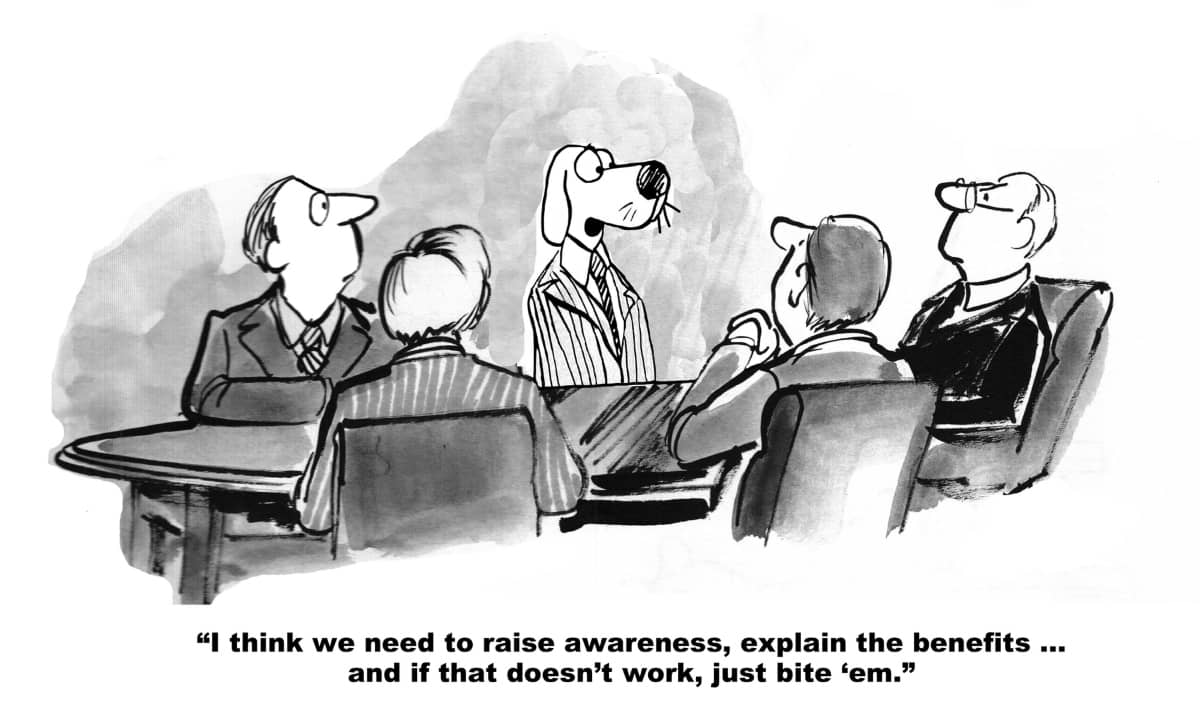Create a B2B Social Media Marketing Strategy in 2025 (10 Tips!)
B2B social media marketing is critical for your brand recognition and for finding your audience.
Social media illiteracy is not only a disadvantage; it’s a stalled motor in the middle of a high-stakes race.
The decision-makers you want to reach are on social media.
That’s where you stand the best chance of making connections that lead to lucrative conversions.
Read on for the essential how-to for building an effective B2B social media marketing strategy.
What Is B2B Social Media Marketing?
Put simply, B2B social media marketing uses social networks — from Instagram to Twitter to TikTok — to market your digital products or services to the B2B buyers in your target audience.
With that in mind, an effective social media marketing strategy takes the following into consideration:
- Social channels used by those B2B buyers
- Content those buyers are likely to find useful
- Digital marketing tools that make you more visible to potential prospects
- Social tools that help you stay on top of current trends and hot topics
- Social listening tools that track the competition
- Analytics that measure the results of your B2B marketing efforts
Anything that helps you build and nurture mutually beneficial connections between your brand and the businesses you want to serve, using a social media campaign, is part of your B2B social media strategy.
Some Eye-Opening B2B Social Media Stats
Before we dive into the elements of a super-powered B2B social media marketing strategy, let’s get a clear view of the context by reviewing some key statistics from Content Marketing Institute (among others).
- The top three content distribution channels for B2B marketers are social media platforms (89%), email (87%), and their business website/blog (86%).
- 89% of B2B marketers use social media for this purpose.
- 96% of B2B marketers use LinkedIn for their content marketing and rate it as the top-performing social platform for both organic and paid distribution.
- Twitter and Facebook are tied in next place at 82%. Next is YouTube at 62% and then Instagram at 49%.
- 89% of B2B content marketers use LinkedIn for lead generation.
- Four out of five LinkedIn members (80%) drive business purchasing decisions.
- 83% of B2B marketers use social media ads and/or promoted posts — 23% more than last year.
- According to B2B marketers, search engine marketing (SEM)/pay-per-click (33%) and social media ads/promoted posts (29%) yielded the best content marketing results for their business over the past year.
- In response to COVID-19, 40% of B2B digital content marketers stepped up their investment in social media marketing and online communities.
- 76% of B2B marketers use social media analytics to measure the results of their content marketing efforts.
- By 2025, 8 out of 10 B2B sales interactions will happen on digital channels.
- The top technologies used by B2B businesses for content marketing are analytics tools (88%), social media publishing/analytics (81%), and email marketing software (78%).
- 60% of the most successful B2B marketers develop and implement a content marketing strategy.
How to Create a Solid B2B Social Media Marketing Strategy
You need a plan.
And you need one that will make you part of that 60% of the most successful B2B marketers — or even the top 10%.
So, where do you begin?
1. Prioritize business objectives when setting goals.
Your B2B social media marketing strategy starts with two questions: what are your business objectives, and how will B2B social media marketing help you achieve them?
While B2C social marketing is all about driving sales, B2B social marketing focuses on more long-term, “top of funnel” objectives. The top three rank well above sales as a priority:
- Creating brand awareness
- Building credibility
- Educating the audience
Before your prospects talk business, they want to see you out there on social being helpful without the expectation of a reward.
They want to see that you know your stuff and can help them understand it better, too.
They want to trust you before they open their wallets.
Because with B2B purchases, the stakes are higher.
Establish SMART goals.
Setting SMART goals for your B2B social marketing strategy is how you translate your big picture goals into measurable steps toward the success you want to see.
Every SMART goal is Specific, Measurable, Attainable, Realistic, and Timely.
Specific, measurable KPIs (key performance indicators) are critical to the success of your B2B business.
Those will decide which metrics to track, so you can measure your progress toward each objective.
- Increase user engagement with B2B content
- Increase click-through with social media ads
- Boost traffic to your B2B company blog/website
Increase brand awareness.
To build relationships and build brand awareness with potential B2B buyers, you need a brand that stands out from the competition.

For that, you need to conduct a competitive analysis.
As a B2B marketer, you also need to get clear on what your brand is all about — what you’re trying to do and what makes you different from the competition and their values.
Social media is the best place to share free and valuable content that will start conversations and make your B2B brand a goldmine for decision-makers.
Educate the audience.
The best way to build credibility and trust with B2B buyers is through educational and actionable social media content in a variety of formats:
- Long-form text downloads
- How-to videos
- Podcast episodes
- Online or email courses
According to a Semrush tweet, “B2B blogs that create educational content receive 52% more organic traffic than those that mainly publish content about their company.”
Identify the information your ideal prospects want. Then make it easy for them to find it and link it to your brand.
Build trust and credibility.

B2B buyers are more likely to trust a brand that buyers like them have trusted and recommended.
Let your customer advocates speak for you in their own words:
- Customer testimonials (text, image, or video)
- Retweets with content from satisfied customers
- Praise for your brand’s customer service
- Affiliate videos demonstrating your product or service
- Influencer marketing content
Aside from creating and distributing helpful content, you need to be out there engaging with your target audience — answering questions, responding to comments, etc.
And while extremely useful, marketing automation can only get you so far.
2. Keep tabs on your competitors.
We’ve mentioned the importance of tracking your competition and finding the gaps in their B2B marketing strategy.
But what specifically should you look at?
- What campaigns are they running?
- Who is their target audience?
- What’s the click-through rate on their social media ads?
- How many likes and shares are they getting?
- Which content types are getting the most engagement?
Social media marketing tools with competitor analysis tools allow you to see what’s working for them and where their B2B social media strategy is falling short.
3. Find social media marketing opportunities.
Use what you learn from social listening tools in a S.W.O.T. analysis of your social media competitive landscape, assessing the strengths, weaknesses, opportunities, and threats.
Knowledge of each of these is the foundation of your B2B social media strategy.
You’ll also find opportunities in trending topics, particularly those your competition isn’t talking about.
Keyword tools that generate lists of recent conversations (blog posts, podcast episodes, trending hashtags) make it easier to identify your best opportunities for engagement.
4. Make it personal.
B2B buyers are human beings with motivations and triggers like anyone else.
Knowing what they want and why is critical to your success on social media.
Yet only about 56% of B2B marketers use buyer personas to guide their content strategy.
It’s a missed opportunity.
Because making your B2B content personal for your ideal buyers is a lot easier when you have a detailed buyer persona in mind.
The more real the persona, the easier it is to create content they’ll appreciate.
5. Choose social platforms wisely.

According to recent research, the top five social media platforms for B2B marketing are LinkedIn, Twitter, Instagram, YouTube, and Facebook.
That said, your buyer persona should include detailed information on your ideal prospect’s social media usage, including the social platforms they frequent, how they use each one and the content they like and share.
Once you know the essential details, prioritize one or two of the social networks they use most and focus on content that gets the most digital engagement.
6. Buh-bye boring content.
You can take the most objectively mundane product or service and create content that excites your target audience and engages them in conversations they don’t want to quit.
Features alone will not give your brand the wow factor.
Your B2B buyers need to know your product or service will get them the benefits they want.
This is where it gets fun.
Use a unique brand voice.
Not sure what your brand voice is all about?
Look over past blog posts, landing page copy, emails, and, of course, your social media messaging. Notice the emotion and tone in the copy you’ve shared.
Notice the content that gets the most engagement, and read the comments for clues.
Then, once you’ve identified your brand voice, be consistent in your use of it on social media and other platforms.
This is your brand’s online personality.
And you only get one.
Repurpose your content for social platforms.
Once you identify your brand voice, you can convert blog posts, podcast episodes, interviews, case studies, white papers, and other long-form content into a social media post, including visuals:
- Infographics
- Brief tutorial videos
- Animated stories
- Super-short, funny video clips
- Comics
Brainstorm a list of all the different ways you can share the same stories and ideas behind your longer content.
Then try something new and track your results.
Stay up-to-date on what’s trending.

Take part in conversations your audiences want to have, even if it has little to do with your product or service.
The best B2B marketers stay on top of industry trends such as:
- New promotional tactics
- The rise and fall of companies
- Hot takes on trending news
- Industry insights
- Digital marketing trends
To save time, invest in a hard-working social media management app with social listening.
That way, you can put more time into planning, creating, and posting timely content.
Experiment with multimedia.
Take a cue from social media platforms like Twitter, where instead of a steady stream of text-only posts, you’ll see memes, polls, videos, photo collages, and GIFs.
Sometimes, all you need to build more buzz around your brand is to switch up your content formats.
Here are a few ideas:
- Use text to video AI to transform a blog post or list into an engaging animated video or an infographic
- Instead of linking to a podcast episode, share a brief snippet
- Use Twitter threads and long-form text posts instead of sharing external links
7. Let your employees be your brand ambassadors.

Consider the benefits of letting your employees advocate for your brand:
- Spotlighting employees makes your brand more human and relatable
- Staff members in company photos will share those with their networks
- Employee advocates feel invested in your brand’s success
- Employee accounts expand your reach on social media
- Employee voices give your audience a taste of your company culture
Engaged employees who are passionate brand affiliates will get your messaging out more widely and efficiently than your B2B marketing experts can do on their own.
8. Focus on engagement.
As with any B2C company, if your potential customers are trying to get a response from you on social media, and they get nothing — for hours — it’s not a good look.
Putting potential customers front and center with social media engagement just makes sense.
Buyers need to know you’ll be reachable if something goes wrong.
While email and website chatbots are still useful, social media offers your audience a faster and more transparent medium for asking questions, exchanging feedback, and learning from other conversations.
9. Post on a consistent schedule.
Posting useful, engaging content every day to every social channel takes time, creative energy, and careful planning.
When you’re just getting started, focus on value and consistency over frequency.
Post content that adds to important conversations in your industry.
Many social media tools, such as social media automation tools, allow you to create a publishing calendar and schedule posts ahead of time.
Use that to plan your content around industry-specific keywords and social media marketing trends.
Experiment with posting times to see which gets the most engagement.
10. Measure content performance.
Social media analytics can track engagement metrics like click-throughs, likes, shares, and comments, and increases in traffic and sales.
Analytics and reporting provide a by-the-numbers view of the success of your social media effort. This is where the M (measurable) in SMART goals comes in.
Your analytics reveal where you are with your KPIs, what content works best on each social media platform, and where you need to make improvements.
- What are you doing that isn’t working?
- What’s the ROI for your social media ads?
- What could you change for better results?
What B2B Social Media Marketing Tactics Will You Focus on First?
You’re now well on your way to creating a B2B social media marketing plan that will turn your brand into a recognized and trusted authority in your industry.
An effective B2B social media marketing strategy builds brand loyalty and increases customer engagement.